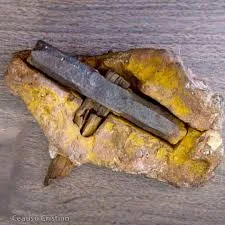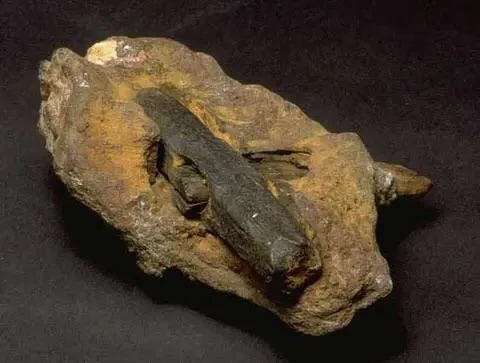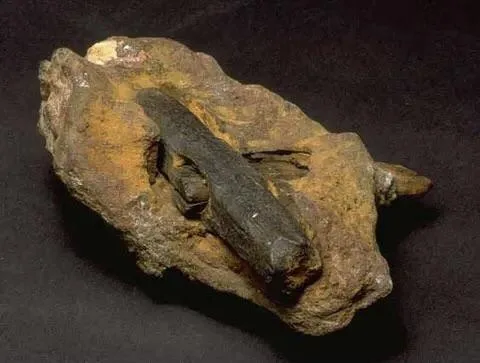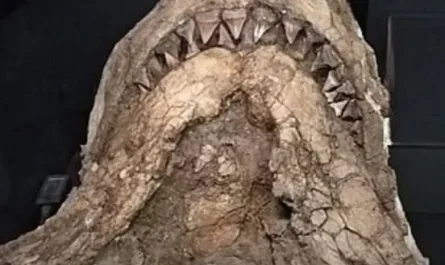The London Hammer: A Geological Puzzle or Out-of-Place Enigma?
In the small town of London, Texas, a curious artifact known as the London Hammer has sparked debate for decades, blending the allure of ancient mystery with modern skepticism. Discovered in 1936 by Max and Emma Hahn near Red Creek, this six-inch iron hammer, with a one-inch diameter head and a partially carbonized wooden handle, was found embedded in rock allegedly 400 million years old. Its pristine condition—no rust on the iron head despite its supposed age—has fueled speculation about its origins, making it a celebrated “Out-of-Place Artifact” (OOPArt) that challenges conventional timelines of human history.

The Discovery
While hiking along Red Creek, the Hahns stumbled upon a piece of wood protruding from a rock. In 1947, their son, George, broke open the stone, revealing an iron hammerhead attached to the wood. The find remained a local oddity until 1983, when Carl Baugh, a Young Earth creationist, championed it as evidence of human existence before the biblical flood, suggesting a 6,000–10,000-year-old Earth. Baugh’s claims placed the hammer in rock dated to the Cretaceous period (65–135 million years ago), far predating human tool-making.

A Hammer Out of Time?
The London Hammer’s composition adds to its intrigue. The head, made of 96.6% iron, 2.6% chlorine, and 0.74% sulfur, shows no rust, a rarity for iron exposed to the elements since the late 1800s, when it’s believed to date. The wooden handle, unmineralized but with traces of carbonization, suggests partial coalification, hinting at unusual preservation conditions. The absence of sharp nicks on the rock indicates it wasn’t chiseled out but found loose, as the Hahns claimed.
Yet, the rock’s age is contentious. Some argue it matches local Ordovician or Devonian formations (400–500 million years old), while skeptics, like geologist Glen J. Kuban, suggest it could be younger, possibly from a natural concretion process. J.R. Cole of the National Center for Science Education, writing in 1985, explained that modern objects can become encased in stone when minerals, like calcite, harden around them in cracks or soil—a process taking decades, not millennia.

Theories and Skepticism
The hammer’s lack of rust is puzzling but not impossible. Its unique alloy, with chlorine and sulfur, may resist corrosion, or the rock’s dry, mineral-rich environment could have protected it. However, claims of a 400-million-year-old origin lack rigor. Carbon-14 testing, which could date the wooden handle, has not been publicly conducted, with Baugh’s private tests yielding no verifiable results. Kuban argues there’s no evidence the hammer was embedded in ancient rock, suggesting it was likely a 19th-century tool—possibly a miner’s hammer—encased through natural geological processes.
Supporters of the OOPArt narrative see the hammer as proof of advanced ancient civilizations or even time travel. Others, grounded in science, view it as a misunderstanding of geology, akin to concretions found in Texas that encase modern objects. The lack of precise excavation records and the hammer’s current private ownership further cloud its authenticity.
A Symbol of Curiosity
The London Hammer, now housed in Baugh’s Creation Evidence Museum in Glen Rose, Texas, remains a captivating mystery. Whether it’s a geological quirk or a challenge to history, it embodies humanity’s relentless quest for meaning. For some, it’s a relic of an impossible past; for others, a reminder that nature can deceive the untrained eye. Until rigorous testing—such as radiocarbon dating or detailed geological analysis—is conducted, the hammer will continue to spark wonder and debate, a six-inch enigma bridging the ancient and the modern.





